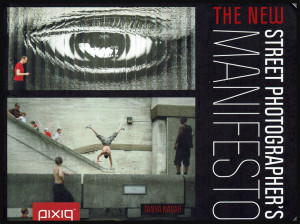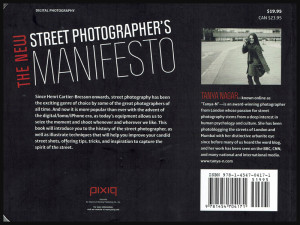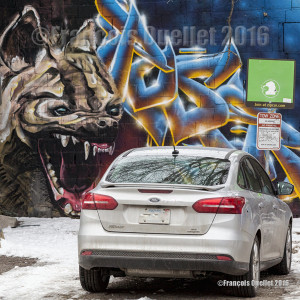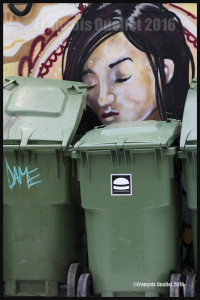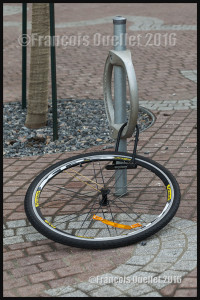Tanya Nagar is an award-winning photographer from London. Her book, “The new street photographer’s manifesto” is perfect for those who aim to improve their street photography techniques. The present article is not a comprehensive critic of her book but an overview of what a reader will find. I also highlighted some tips in photography that will help to improve the street photographer’s performance.
Tanya’s manifesto not only contains technical advices helping a photographer to improve his shots but also some tips to avoid common mistakes. Subjects include: timing, composition, shooting portraits, framing and juxtaposition, perspective and angles, the choice between landscape and portrait, depth of field, shutter speed, exposure, night photography, rule of thirds, etc.
The book’s content is divided in six categories: 1. Street Photography 2. Where & What to Shoot 3. Seize the Moment 4. Equipment 5. Digital Processing 6. Showcase.
1. Street photography requires the ability to seize a life moment with precision and timing. It is about candid shots and does not have to include humans, as long as it fixes a moment in life. It certainly can include animals (in fact, animals are a very popular subject).
2. It is best if you use a light, discrete camera (even an I-Phone). Walking with a huge camera with big lenses makes you look like a professional photographer and people will see you coming. The trick is to avoid drawing attention. Coughing while clicking drowns out the sound of the camera. You might also think of “shooting from the hip” or “shooting blind”. Those techniques are explained in the book and can be mastered with a bit of practice.
3. It takes a bit of courage to photograph situations that include people since you never know what to expect when you raise your camera. Respect the different cultures and personal space and don’t be afraid to smile and explain what you are doing. If somebody refuses to be photographed, move on, don’t dwell on the situation.
4. In order to gain experience and a feeling of security at taking pictures of people on the street, start with protests or parades.
5. It is a good thing to know the laws pertaining to photography of the country you are visiting. Police officers in some countries might be tempted to order you to delete a shot while they actually don’t have the right to. Often, a misunderstanding by police or security guards of anti-terrorism legislation leads to different interpretations and subsequently to abuse towards a photographer. Just make sure you stay up to date with the country’s regulations.
6. You might think of shooting from within your vehicle to obtain interesting results (while respecting the country’s laws).
7. Use graffitis, signs, graphical billboards, text and advertising logos.
8. Use contrasts like big versus small, light versus dark, rich versus poor, etc.
9. Bear attention to details and look for second degree interpretation of a situation.
10. Look for amusing, funny and unusual captures.
11. Make sure you master your camera in order to be quick when the perfect opportunity comes. Set most of the parameters of the camera before actually arriving on a scene (you already have an idea of the light intensity in the area and the ISO setting that will be required to obtain the speed you desire).
12. Be cautious when it comes to taking pictures of children. Societies change and authorization from the child’s parents is required almost every time.
13. “The only way to avoid missing a moment is by carrying your camera at all times”. Therefore, get something small and light.
The book holds a section dedicated to multiple types of cameras: rangefinders, SLR and DSLR, four thirds and micro four thirds, medium format, point-and-shoot compact cameras, camera phones, toy and pinhole cameras. Their advantages and disadvantages are clearly explained.
The reader will also find some information about lenses (the best for street photography and what to avoid) and the effects obtained through the use of different type of films (colored, black and white, expired).
The fifth section of the book relates to digital processing and the basic image editing techniques like cropping, rotating, the use of the “Curves” command, as well as dodging and burning.
The final section, “Showcase”, presents many well-known street photographers from around the world, including few photos taken by each of them to allow the reader to have an overview of each photographer’s personal style and creativity. Presented in order are: Antonio Navarro Wijkmark, Brian Quentin Webb, Charlotte Gonzalez, Claire Atkinson, Danny Santos II, Felix Lupa, Ferhat Çelik, Mustafa Abdulaziz, Ronya Galka, Seamus Travers and Severin Koller.
This is certainly a very interesting and practical photography book that will help you avoid costly mistakes (missed photo opportunities or buying the wrong photography equipment) while helping you to improve your knowledge on street photography as much as the quality of your shots.
Here is a link towards Tanya Nagar’s website: Tanya Nagar
For other photography book reviews, click on the following link: Other photography books
Title: The new street photographer’s manifesto.
Author: Tanya Nagar
©The Ilex Press Limited 2012
ISBN: 978-1-4547-0417-1
